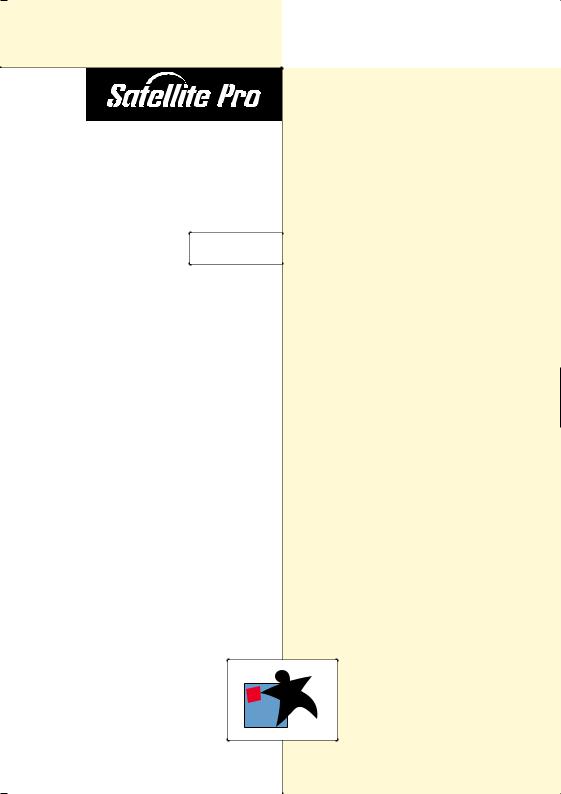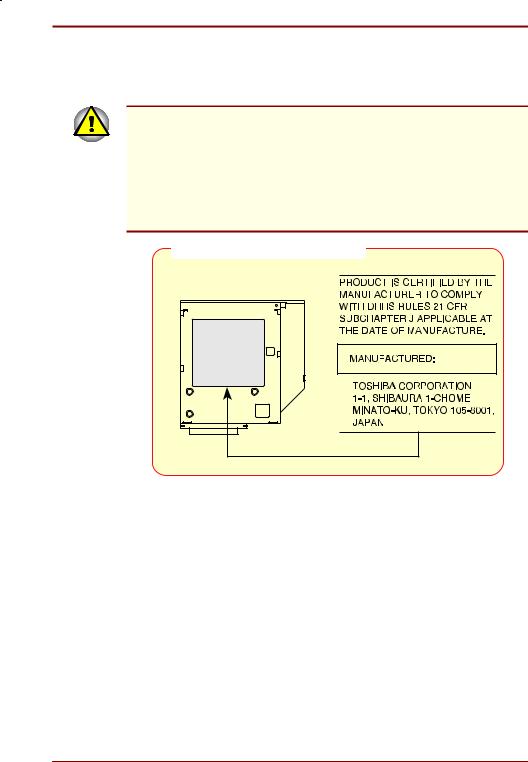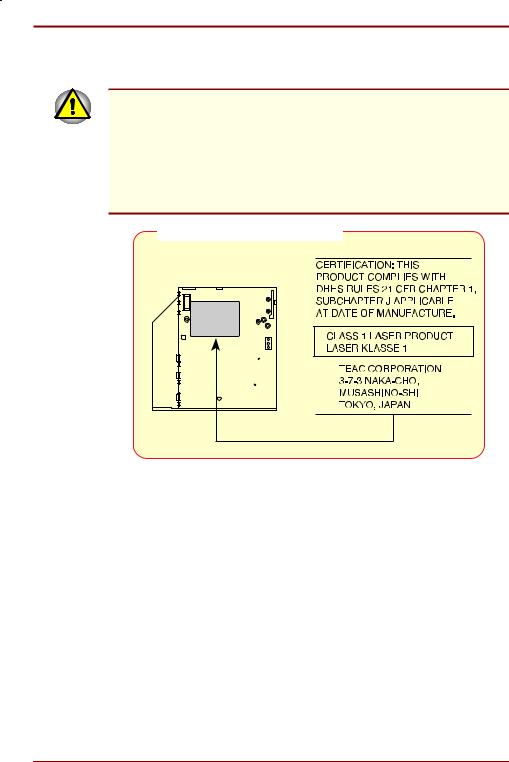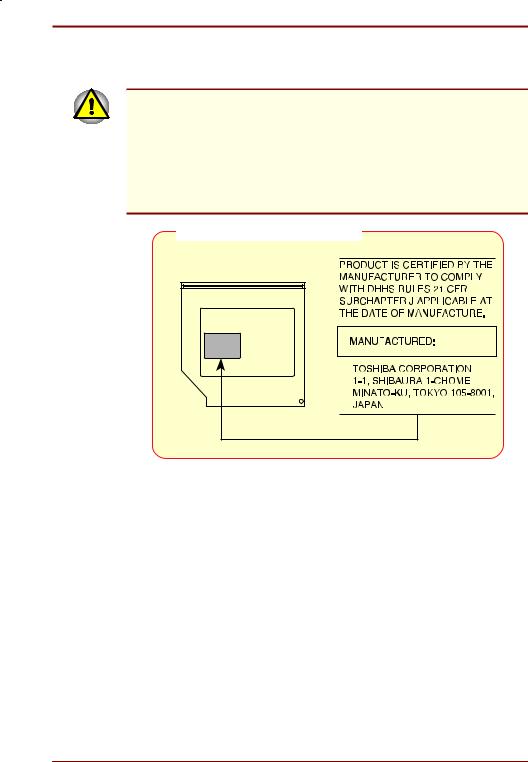Toshiba SATELLITE PRO 4300, SATELLITE PRO 4200 User Manual

TOSHIBA 
U S E R ' S M A N UA L
M o d e l 4 2 0 0 / 4 3 0 0 S e r i e s
R

Copyright
© 2000 by Toshiba Corporation. All rights reserved. Under the copyright laws, this manual cannot be reproduced in any form without the prior written permission of Toshiba. No patent liability is assumed, with respect to the use of the information contained herein.
Toshiba Satellite Pro 4200/4300 Series Portable Personal Computer User’s Manual
First edition January 2000
Disclaimer
This manual has been validated and reviewed for accuracy. The instructions and descriptions it contains are accurate for the Satellite Pro 4200/4300 Series Portable Personal Computers at the time of this manual’s production. However, succeeding computers and manuals are subject to change without notice. Toshiba assumes no liability for damages incurred directly or indirectly from errors, omissions or discrepancies between the computer and the manual.
Trademarks
IBM is a registered trademark and IBM PC, OS/2, and PS/2 are trademarks of International Business Machines Corporation.
Pentium is a registered trademark of Intel Corporation.
MS-DOS, Microsoft, Windows, Windows NT and DirectX are registered trademarks of Microsoft Corporation.
Sound Blaster and Pro are trademarks of Creative Technology Ltd.
Novell and NetWare are registered trademarks of Novell, Inc.
UNIX is a registered trademark of X/Open Company Ltd.
LapLink is a registered trademark of Travelling Software Inc.
RingCentral is a trademark of Motorola, Inc.
Centronics is a registered trademark of Centronics Data Computer
Corporation.
Photo CD is a trademark of Eastman Kodak.
DVDExpress is a trademark of National Semiconductor Corporation.
K56 flex is a trademark of lucent technologies and Rockwell Semiconductor Systems.
Other trademarks and registered trademarks not listed above may be used in this manual.
ii |
User's Manual |

EU Declaration of Conformity
This product carries the CE-Mark in accordance with the related European Directives. CE-Marking is the responsibility of Toshiba Europe, Hammfelddamm 8, 41460 Neuss, Germany.
User's Manual |
iii |

|
|
|
|
iv |
User's Manual |
|
|

Toshiba DVD-ROM drive SD-C2302** safety instructions
**means any letters or numbers.
The DVD-ROM drive employs a laser system. To ensure proper use of this product, please read this instruction manual carefully and retain for future reference. Should the unit ever require maintenance, contact an authorised service location.
Use of controls, adjustments or the performance of procedures other than those specified may result in hazardous radiation exposure.
To prevent direct exposure to the laser beam, do not try to open the enclosure.
Location of the required label
|
|
CAUTION: This appliance contains a laser system and is |
|
|
|
|
|
classified as a “CLASS 1 LASER PRODUCT”. To use this |
|
|
model properly, read the instruction manual carefully and keep |
|
|
this manual for your future reference. In case of any trouble |
|
|
with this model, please contact your nearest “AUTHORISED |
|
||
|
|
service station”. To prevent direct exposure to the laser beam, |
|
|
do not try to open the enclosure. |
|
|
CAUTION: USE OF CONTROLS OR ADJUSTMENTS OR |
|
|
PERFORMANCE OF PROCEDURES OTHER THAN THOSE |
|
|
SPECIFIED IN THE OWNER’S MANUAL MAY RESULT IN |
|
|
HAZARDOUS RADIATION EXPOSURE. |
|
|
|
User's Manual |
v |

TEAC CD-ROM drive CD-224E safety instructions
The CD-ROM drive employs a laser system. To ensure proper use of this product, please read this instruction manual carefully and retain for future reference. Should the unit ever require maintenance, contact an authorised service location.
Use of controls, adjustments or the performance of procedures other than those specified may result in hazardous radiation exposure.
To prevent direct exposure to the laser beam, do not try to open the enclosure.
Location of the required label
|
|
CAUTION: This appliance contains a laser system and is |
|
|
|
|
|
classified as a “CLASS 1 LASER PRODUCT”. To use this |
|
|
model properly, read the instruction manual carefully and keep |
|
|
this manual for your future reference. In case of any trouble |
|
|
with this model, please contact your nearest “AUTHORISED |
|
||
|
|
service station”. To prevent direct exposure to the laser beam, |
|
|
do not try to open the enclosure. |
|
|
CAUTION: USE OF CONTROLS OR ADJUSTMENTS OR |
|
|
PERFORMANCE OF PROCEDURES OTHER THAN THOSE |
|
|
SPECIFIED IN THE OWNER’S MANUAL MAY RESULT IN |
|
|
HAZARDOUS RADIATION EXPOSURE. |
|
|
|
vi |
User's Manual |

Toshiba CD-ROM drive XM-1902B safety instructions
The CD-ROM drive employs a laser system. To ensure proper use of this product, please read this instruction manual carefully and retain for future reference. Should the unit ever require maintenance, contact an authorised service location.
Use of controls, adjustments or the performance of procedures other than those specified may result in hazardous radiation exposure.
To prevent direct exposure to the laser beam, do not try to open the enclosure.
Location of the required label
|
|
CAUTION: This appliance contains a laser system and is |
|
|
|
|
|
classified as a “CLASS 1 LASER PRODUCT”. To use this |
|
|
model properly, read the instruction manual carefully and keep |
|
|
this manual for your future reference. In case of any trouble |
|
|
with this model, please contact your nearest “AUTHORISED |
|
||
|
|
service station”. To prevent direct exposure to the laser beam, |
|
|
do not try to open the enclosure. |
|
|
CAUTION: USE OF CONTROLS OR ADJUSTMENTS OR |
|
|
PERFORMANCE OF PROCEDURES OTHER THAN THOSE |
|
|
SPECIFIED IN THE OWNER’S MANUAL MAY RESULT IN |
|
|
HAZARDOUS RADIATION EXPOSURE. |
|
|
|
User's Manual |
vii |

General Precautions
Toshiba computers are designed to optimise safety, minimise strain and withstand the rigours of portability. However, certain precautions should be observed to further reduce the risk of personal injury or damage to the computer.
Be certain to read the general precautions below and to note the cautions included in the text of the manual.
Stress injury
Carefully read the Safety Instruction Manual. It contains information on prevention of stress injuries to your hands and wrists that can be caused by extensive keyboard use. Chapter 3, Getting Started, also includes information on work space design, posture and lighting that can help reduce physical stress.
Heat Warning
The base of the PC can become very warm; while the temperature will not be too hot to the touch, prolonged physical contact may result in a temporary heat imprint on the skin. It is recommended that prolonged physical contact is avoided.
Also, if the computer has been used for a long time, avoid direct contact with the metal plate supporting the I/O ports. It can become hot.
Mobile phones
Use of mobile phones can interfere with the PC sound system. The PC operation is not impaired but it is recommended that a distance of 30 cm is maintained between the PC & the mobile phone.
Pressure or impact damage
Do not apply heavy pressure to the computer or subject it to strong impact. Excessive pressure or impact can cause damage to computer components or otherwise cause malfunctions.
PC card overheating
Some PC cards can become hot with prolonged use. If two cards are installed, both can become hot even if only one is used extensively. Overheating of a PC card can result in errors or instability in the PC card operation. Also, be careful when you remove a PC card that has been used for a long time.
viii |
User's Manual |

CE compliance
This product and the original options are designed to observe the related EMC (Electromagnetic compatibility) and safety standards. However, Toshiba should not guarantee that this product still observes these EMC standards if options or cables not produced by Toshiba are connected or implemented. In this case the persons who have connected / implemented those options / cables have to assure that the system (PC plus options / cables) still fulfils the required standards. To avoid in general EMC problems following advice should be observed:
Only CE marked options should be connected / implemented
Only best shielded cables should be connected
Working environment
This product was designed to fulfil the EMC (electromagnetic compatibility) requirements to be observed for so-called "Residential, commercial and light industry environments".
Toshiba do not approve the use of this product in working environments other than the above mentioned "Residential, commercial and light industry environments".
For example, the following environments are not approved:
Industrial Environments (environments with a mains voltage >230V~)
Medical Environments
Automotive Environments
Aircraft Environments
If this product is supplied with a network port, please refer to the paragraph "Network connection".
Any consequences resulting from the use of this product in working environments that are not approved are not the responsibility of Toshiba Europe GmbH.
The consequences of the use of this product in non-approved working environments may be:
Interference with other devices or machines in the near surrounding area
Malfunction of, or data loss from, this product caused by disturbances generated by other devices or machines in the near surrounding area
Therefore Toshiba strongly recommend that the electromagnetic compatibility of this product should be suitably tested in all non-approved working environments before use. In the case of automobiles or aircraft, the manufacturer or airline respectively should be asked for permission before use of this product.
Furthermore, for general safety reasons, the use of this product in environments with explosive atmospheres is not permitted.
User's Manual |
ix |

Network connection (class A warning)
If this product has networking capabilities and will be connected to a network, Class A radiation limits will be observed (in accordance with technical conventions). This means that if the product will be used in a domestic environment, other devices in the near surrounding may suffer interference. Consequently, please do not use this product in such environments (for example a living room), otherwise you could be held responsible for any ensuing interference.
Conformity Statement
The equipment has been approved to [Commission Decision “CTR21”] for pan-European single terminal connection to the Public Switched Telephone Network (PSTN). However, due to differences between the individual PSTNs provided in different countries the approval does not, of itself, give an unconditional assurance of successful operation on every PSTN network termination point.
In the event of problems, you should contact your equipment supplier in the first instance.
Network Compatibility Statement
This product is designed to work with, and is compatible with the following networks. It has been tested to and found to conform with the additional requirements contained in EG 201 121.
Germany |
- ATAAB AN005, AN006, AN007, AN009, AN010, |
|
and DE03, 04, 05, 08, 09, 12, 14, 17 |
|
|
Greece |
- ATAAB AN005, AN006 and GR01, 02, 03, 04 |
|
|
Portugal |
- ATAAB AN001, 005, 006, 007, 011 |
|
and P03, 04, 08, 10 |
|
|
Spain |
- ATAAB AN005, 007, 012, and ES01 |
|
|
Switzerland |
- ATAAB AN002 |
|
|
All other countries |
- ATAAB AN003, 004 |
Specific switch settings or software setup are required for each network, please refer to the relevant sections of the user guide for more details.
The hookflash (timed break register recall) function is subject to separate national type approval. It has not been tested for conformity to national type regulations, and no guarantee of successful operation of that specific function on specific national networks can be given.
x |
User's Manual |

Table of Contents
Preface....................................................................................... |
xvii |
Manual contents .................................................................................... |
xvii |
Conventions .......................................................................................... |
xviii |
Abbreviations ..................................................................................... |
xviii |
Icons................................................................................................... |
xviii |
Keys ................................................................................................... |
xviii |
Key operation...................................................................................... |
xix |
Display ................................................................................................ |
xix |
Messages............................................................................................ |
xix |
Chapter 1: Introduction |
.............................................................1-1 |
Equipment checklist.............................................................................. |
1-1 |
Features.................................................................................................. |
1-2 |
Special features ..................................................................................... |
1-7 |
Utilities.................................................................................................. |
1-10 |
Options .................................................................................................. |
1-11 |
Chapter 2: The Grand Tour ....................................................... |
2-1 |
Front with the display closed ............................................................... |
2-1 |
Left side .................................................................................................. |
2-2 |
Right side ............................................................................................... |
2-3 |
Back side ................................................................................................ |
2-4 |
Underside ............................................................................................... |
2-6 |
Front with the display open.................................................................. |
2-7 |
Indicators................................................................................................ |
2-8 |
Drives.................................................................................................... |
2-10 |
3 ½" diskette drive............................................................................ |
2-10 |
DVD-ROM drive (available for some Satellite Pro 4320 Series) ..... |
2-10 |
CD-ROM drive ................................................................................. |
2-12 |
AC adaptor ........................................................................................... |
2-13 |
User's Manual |
xi |

Chapter 3: Getting Started ........................................................ |
3-1 |
Setting up................................................................................................ |
3-1 |
General conditions.............................................................................. |
3-2 |
Placement of computer....................................................................... |
3-2 |
Seating and posture............................................................................ |
3-3 |
Lighting ............................................................................................... |
3-4 |
Work habits......................................................................................... |
3-4 |
Connecting the AC adaptor................................................................... |
3-5 |
Opening the display ............................................................................... |
3-6 |
Turning on the power............................................................................. |
3-6 |
Turning off the power............................................................................. |
3-7 |
Restarting the computer........................................................................ |
3-7 |
Restoring the preinstalled software ..................................................... |
3-8 |
Restoring the complete system .......................................................... |
3-8 |
Restoring Toshiba utilities and drivers ................................................ |
3-8 |
Chapter 4: Operating Basics..................................................... |
4-1 |
Using AccuPoint™ II .............................................................................. |
4-1 |
AccuPoint™ II precautions ................................................................. |
4-2 |
Replacing the cap ............................................................................... |
4-2 |
Using CD-ROM/DVD-ROM drives.......................................................... |
4-3 |
Loading compact discs ....................................................................... |
4-3 |
Removing compact discs.................................................................... |
4-6 |
Disk care ................................................................................................. |
4-7 |
CDs..................................................................................................... |
4-7 |
Diskette Care ...................................................................................... |
4-8 |
International modem .............................................................................. |
4-8 |
Country selection ................................................................................ |
4-8 |
Video out ............................................................................................... |
4-11 |
Cleaning the computer ........................................................................ |
4-11 |
Moving the computer ........................................................................... |
4-11 |
Heat dispersal....................................................................................... |
4-12 |
Chapter 5: The Keyboard .......................................................... |
5-1 |
Grey keys ................................................................................................ |
5-1 |
F1…F12 function keys ........................................................................... |
5-2 |
Soft Keys: Alt Gr Key Combinations .................................................... |
5-2 |
The Euro symbol................................................................................. |
5-2 |
xii |
User's Manual |

Soft keys: Fn key combinations........................................................... |
5-3 |
Emulating keys on enhanced keyboard............................................. |
5-3 |
Hotkeys .............................................................................................. |
5-4 |
Windows special keys........................................................................ |
5-6 |
Emulating Fn key on external keyboard ............................................ |
5-6 |
Keypad overlay ...................................................................................... |
5-6 |
Turning on the overlays...................................................................... |
5-6 |
Temporarily using normal keyboard (overlay on)............................... |
5-7 |
Temporarily using overlay (overlay off) .............................................. |
5-8 |
Temporarily changing modes ............................................................. |
5-8 |
Generating ASCII characters ................................................................ |
5-8 |
Chapter 6: Power and Power-Up Modes |
..................................6-1 |
Power conditions................................................................................... |
6-1 |
Power indicators.................................................................................... |
6-2 |
Battery indicators ............................................................................... |
6-2 |
DC IN indicator................................................................................... |
6-3 |
Power indicator .................................................................................. |
6-3 |
Battery types .......................................................................................... |
6-4 |
Battery pack ....................................................................................... |
6-4 |
Real Time Clock battery..................................................................... |
6-4 |
Care and use of the battery pack ......................................................... |
6-5 |
Safety precautions ............................................................................. |
6-5 |
Charging the batteries........................................................................ |
6-6 |
Monitoring battery capacity ................................................................ |
6-7 |
Maximising battery operating time ..................................................... |
6-7 |
Retaining data with power off............................................................. |
6-8 |
Extending battery life ......................................................................... |
6-8 |
Replacing the battery pack ................................................................... |
6-8 |
Removing the battery pack ................................................................ |
6-8 |
Installing the battery pack ................................................................ |
6-10 |
Starting the computer by password ................................................... |
6-11 |
Power-up modes.................................................................................. |
6-12 |
Hotkeys ............................................................................................ |
6-13 |
TSETUP ........................................................................................... |
6-13 |
Panel power off .................................................................................... |
6-13 |
System auto off.................................................................................... |
6-13 |
Auto Power On..................................................................................... |
6-13 |
Ring indicator power on...................................................................... |
6-14 |
User's Manual |
xiii |

Chapter 7: Setup and Password Security................................ |
7-1 |
TSETUP ................................................................................................... |
7-1 |
Executing TSETUP............................................................................. |
7-2 |
Changing values in the TSETUP menu .............................................. |
7-3 |
Accepting changes and exiting SYSTEM SETUP .............................. |
7-3 |
Default configuration........................................................................... |
7-3 |
TSETUP options ................................................................................. |
7-4 |
Memory............................................................................................... |
7-4 |
Password ............................................................................................ |
7-4 |
Battery ................................................................................................ |
7-4 |
Hard Disk Mode .................................................................................. |
7-7 |
Password security................................................................................ |
7-15 |
How to set the passwords ................................................................ |
7-16 |
How to reset the passwords ............................................................. |
7-18 |
Enabling TSETUP access in user password mode .......................... |
7-20 |
Making a password service diskette................................................. |
7-22 |
Chapter 8: Optional Devices ..................................................... |
8-1 |
PC Cards ................................................................................................. |
8-1 |
Installing a PC Card............................................................................ |
8-2 |
Removing a PC Card.......................................................................... |
8-4 |
Memory expansion................................................................................. |
8-4 |
Installing memory module................................................................... |
8-5 |
Removing memory module................................................................. |
8-6 |
Clearing Hibernation files ................................................................... |
8-7 |
Additional battery pack.......................................................................... |
8-8 |
Battery charger....................................................................................... |
8-8 |
Card Station IV........................................................................................ |
8-8 |
Front ................................................................................................... |
8-9 |
Right side............................................................................................ |
8-9 |
Back.................................................................................................. |
8-10 |
Left side ............................................................................................ |
8-11 |
AC adaptor........................................................................................ |
8-12 |
Connecting to the Card Station IV .................................................... |
8-13 |
Connecting the AC adaptor .............................................................. |
8-14 |
Disconnecting the Card Station IV.................................................... |
8-14 |
xiv |
User's Manual |

Card Station III...................................................................................... |
8-15 |
Front................................................................................................. |
8-16 |
Right side ......................................................................................... |
8-17 |
Back ................................................................................................. |
8-17 |
Left side............................................................................................ |
8-19 |
Spacer.............................................................................................. |
8-19 |
Connecting to the Card Station III.................................................... |
8-20 |
Connecting the AC adaptor.............................................................. |
8-23 |
Installing and removing PC Cards ................................................... |
8-24 |
Port Replicator ..................................................................................... |
8-26 |
Front................................................................................................. |
8-27 |
Right side ......................................................................................... |
8-28 |
Back ................................................................................................. |
8-28 |
Left side............................................................................................ |
8-29 |
Connecting the Port Replicator ........................................................ |
8-29 |
Connecting the AC adaptor.............................................................. |
8-31 |
Disconnecting the Port Replicator.................................................... |
8-31 |
Parallel printer...................................................................................... |
8-32 |
External monitor .................................................................................. |
8-33 |
PS/2 mouse .......................................................................................... |
8-34 |
PS/2 keyboard ...................................................................................... |
8-34 |
Security lock ........................................................................................ |
8-35 |
Chapter 9: Troubleshooting ...................................................... |
9-1 |
Problem solving process ...................................................................... |
9-1 |
Preliminary checklist .......................................................................... |
9-1 |
Analysing the problem ....................................................................... |
9-2 |
Hardware and system checklist ........................................................... |
9-3 |
System start-up .................................................................................. |
9-3 |
Self test .............................................................................................. |
9-3 |
Power ................................................................................................. |
9-4 |
Password ........................................................................................... |
9-6 |
Hotkeys .............................................................................................. |
9-6 |
Keyboard............................................................................................ |
9-6 |
LCD panel .......................................................................................... |
9-7 |
Hard disk drive ................................................................................... |
9-7 |
CD-ROM drive ................................................................................... |
9-8 |
User's Manual |
xv |

DVD-ROM drive.................................................................................. |
9-9 |
Diskette drive .................................................................................... |
9-10 |
Infrared port ...................................................................................... |
9-10 |
Printer ............................................................................................... |
9-11 |
Pointing device ................................................................................. |
9-11 |
PC Card ............................................................................................ |
9-13 |
Monitor.............................................................................................. |
9-13 |
Sound system ................................................................................... |
9-14 |
USB .................................................................................................. |
9-14 |
Hibernation ....................................................................................... |
9-15 |
TV output signal................................................................................ |
9-15 |
Memory expansion ........................................................................... |
9-16 |
Diagnostic test...................................................................................... |
9-17 |
Executing the diagnostic test program ............................................. |
9-17 |
Choosing test options ....................................................................... |
9-18 |
Test sequence................................................................................... |
9-19 |
Subtests............................................................................................ |
9-19 |
If you need further assistance ............................................................ |
9-25 |
Before you call .................................................................................. |
9-25 |
Where to write................................................................................... |
9-25 |
Appendix A: Specifications...................................................... |
A-1 |
Appendix B: AC Power Cord and Connectors ....................... |
B-1 |
Appendix C: The Toshiba International Warranty .................. |
C-1 |
Appendix D: Keyboard Layouts .............................................. |
D-1 |
Appendix E: Display Controller and Modes ........................... |
E-1 |
Appendix F: If your computer is stolen ................................... |
F-1 |
Appendix G: ASCII Character Codes ...................................... |
G-1 |
Appendix H: International Modem Guide................................ |
H-1 |
Glossary .................................................................................... |
H-1 |
Index .......................................................................................... |
H-1 |
xvi |
User's Manual |

Preface
Congratulations on your purchase of the Satellite Pro 4200 or 4300 Series computer. This powerful notebook computer provides excellent expansion capability, including multimedia devices, and it is designed to provide years of reliable, high-performance computing.
This manual tells how to set up and begin using your Satellite Pro 4200 or 4300 Series computer. It also provides detailed information on configuring your computer, basic operations and care, using optional devices and troubleshooting.
If you are a new user of computers or if you’re new to portable computing, first read over the Introduction and The Grand Tour chapters to familiarise yourself with the computer’s features, components and accessory devices. Then read Getting Started for step-by-step instructions on setting up your computer.
If you are an experienced computer user, please continue reading the preface to learn how this manual is organised, then become acquainted with this manual by browsing through its pages. Be sure to look over the Special features section of the Introduction, to learn about features that are uncommon or unique to the computers and carefully read Setup and Password Security.
Manual contents
This manual is composed of 9 chapters, 8 appendices, a glossary, and an index.
Chapter 1, Introduction, is an overview of the computer’s features, capabilities, and options.
Chapter 2, The Grand Tour, identifies the components of the computer and briefly explains how they function.
Chapter 3, Getting Started, provides a quick overview of how to begin operating your computer and gives tips on safety and designing your work area.
Chapter 4, Operating Basics, includes instructions on using the following devices: AccuPoint™ II, CD/DVD-ROM drive and internal modem. It also provides tips on care of the computer, diskettes and CD/DVD-ROMs.
User's Manual |
xvii |

Chapter 5, The Keyboard, describes special keyboard functions including the keypad overlay and hotkeys.
Chapter 6, Power and Power-Up Modes, gives details on the computer’s power resources and battery save modes.
Chapter 7, Setup and Password Security, explains how to configure the computer using the TSETUP program. It also tells how to set a password.
Chapter 8, Optional Devices, describes the optional hardware available.
Chapter 9, Troubleshooting, provides helpful information on how to perform some diagnostic tests, and suggests courses of action if the computer doesn’t seem to be working properly.
The Appendices provide technical information about your computer.
The Glossary defines general computer terminology and includes a list of acronyms used in the text.
The Index quickly directs you to the information contained in this manual.
Conventions
This manual uses the following formats to describe, identify, and highlight terms and operating procedures.
Abbreviations
On first appearance, and whenever necessary for clarity, abbreviations are enclosed in parentheses following their definition. For example: Read Only Memory (ROM). Acronyms are also defined in the Glossary.
Icons
Icons identify ports, dials, and other parts of your computer. The indicator panel also uses icons to identify the components it is providing information on.
Keys
The keyboard keys are used in the text to describe many computer operations. A distinctive typeface identifies the key top symbols as they appear on the keyboard. For example, Enter identifies the Enter key.
xviii |
User's Manual |

Key operation
Some operations require you to simultaneously use two or more keys. We identify such operations by the key top symbols separated by a plus sign (+). For example, Ctrl + C means you must hold down Ctrl and at the same time press C. If three keys are used, hold down the first two and at the same time press the third.
ABC
Display
ABC
Messages
When procedures require an action such as clicking an icon or entering text, the icon’s name or the text you are to type in is represented in the type face you see to the left.
Text you are to type in is usually preceded by the keyboard icon.
Names of windows or icons or text generated by the computer that appears on its display screen is presented in the type face you see to the left.
Text generated by the computer is usually preceded by the screen icon.
Messages are used in this manual to bring important information to your attention. Each type of message is identified as shown below.
Pay attention! A caution informs you that improper use of equipment or failure to follow instructions may cause data loss or damage your equipment.
Please read. A note is a hint or advice that helps you make best use of your equipment.
User's Manual |
xix |

|
|
|
|
xx |
User's Manual |
|
|

Chapter 1
Introduction
This chapter contains an equipment checklist and identifies the computer’s features, options and accessories.
Some of the features described in this manual may not function properly if you use an operating system that was not preinstalled by Toshiba.
Equipment checklist
Carefully unpack your computer. Save the box and packing materials for future use. Check to make sure you have all the following items:
Satellite Pro 4200 or 4300 Series Portable Personal Computer
Universal AC adaptor and power cord
Spare AccuPoint™ II (pointing device) caps
Modular cable (for modem)
The following software preinstalled on your hard disk:
If you have Windows 95, the following software will be retained on the hard disk:
•Microsoft® Windows 95
•Toshiba Utilities
•Modem driver
•Display Driver for Windows
•Sound driver
•Hypertext online help
•DVD Video Player (only on models with a DVD drive)
If you have Windows 98, the following software will be retained on the hard disk:
•Microsoft Windows 98
•The same utilities and drivers that are installed with Windows 95.
Backup CD-ROMs
•Toshiba Product Recovery CD-ROM, containing the complete software image that came pre-installed
Toshiba Tools & Utilities CD-ROM, containing the drivers and utilities that came pre-installed
User's Manual |
Introduction 1-1 |

Your computer’s documentation:
•Satellite Pro 4200 or 4300 Series Personal Computer User’s Manual
•Satellite Pro 4200 or 4300 Series QuickStart
•Microsoft Windows manual package
•Safety Instruction Manual
If any of the items are missing or damaged, contact your dealer immediately.
Features
The computer uses Toshiba’s advanced Large Scale Integration (LSI), Complementary Metal-Oxide Semiconductor (CMOS) technology extensively to provide compact size, minimum weight, low power usage, and high reliability. This computer incorporates the following features and benefits:
Microprocessor |
The computer is equipped with a Mobile |
|
Pentium® III processor which incorporates a |
|
math co-processor and 32 KB cache memory. |
|
4280 Series: 500 megahertz |
|
4320 Series: 600 megahertz featuring |
|
SpeedStep™ technology |
|
The 4270 Series is equipped with a Mobile Celeron |
|
processor, which operates at 500 megahertz. |
|
|
Level 2 cache |
A 256 KB level 2 cache on the Pentium |
|
processors and a 128 KB level 2 cache on the |
|
Celeron processors maximizes performance. |
|
|
Memory |
The computer comes with built-in 64 MB of |
|
Random Access Memory (RAM). Memory can be |
|
expanded up to 320 MB. |
|
|
Video RAM |
The computer provides 8 MB of RAM for |
|
video display. |
|
|
Battery pack |
The computer is powered by a rechargeable |
|
lithium-ion battery pack. |
|
|
RTC battery |
The computer has an internal battery that backs |
|
up the Real Time Clock (RTC) and calendar. |
|
|
1-2 Introduction |
User's Manual |

Display |
The computer supports high-resolution video |
|
graphics and employs a AGP bus for superior |
|
performance. The screen is a 13.0” DSTN screen |
|
with 800 horizontal x 600 vertical pixels or 13.3", |
|
14.1" or 15.0” XGA-TFT with 1024 horizontal x |
|
768 vertical pixels. It can be set at a wide range |
|
of viewing angles for maximum comfort and |
|
readability. The display controller also supports |
|
simultaneous display on the internal LCD and on |
|
an external monitor. |
|
|
Graphics controller |
The graphics controller incorporates a 3D graphics |
|
accelerator to maximize video performance and |
|
enable flickerless display. It also enables display of |
|
up to 1024 x 768 pixels on the computer’s LCD |
|
panel and up to 1600 x 1200 pixels on a high- |
|
resolution external monitor. |
|
Full Accelerated Graphics Port 2X support |
|
features a peak bandwith of 2x the PCI bus. |
|
|
AC adaptor |
The universal AC adaptor provides power to the |
|
system and recharges the batteries. It comes |
|
with a detachable power cord. |
|
Because it is universal, it can receive a range of |
|
AC voltage from 100 to 240 volts; however, the |
|
output current varies among different models. |
|
Using the wrong model can damage your |
|
computer. See the AC adaptor section in |
|
Chapter 2, The Grand Tour. |
|
|
Keyboard |
An easy-to-use 85-key (United States) or 86-key |
|
(Europe) keyboard provides a numeric keypad |
|
overlay for fast numeric data entry or for cursor |
|
and page control. It also includes two keys that |
|
have special functions in Windows; one activates |
|
the Start menu and the other functions as the |
|
secondary mouse button. The computer’s |
|
keyboard supports software that uses a 101or |
|
102-key enhanced keyboard. See Chapter 5, The |
|
Keyboard, for details. |
|
|
AccuPoint™ II |
This pointer control stick, located in the centre of |
|
the keyboard, provides convenient control of the |
|
cursor without requiring desk space for a mouse. |
|
Two additional programmable scroll buttons |
|
provide convenient scrolling through large |
|
documents or web sites |
|
|
User's Manual |
Introduction 1-3 |

Hard disk drive |
The Satellite Pro 4270 or 4280 Series has an |
|||
|
integrated 6.0 gigabyte* , 2 ½" hard disk drive |
|||
|
(HDD) for nonvolatile storage of data and |
|||
|
software. |
|
|
|
|
The Satellite Pro 4320 Series has an integrated |
|||
|
12 gigabyte*, 2 ½" hard disk drive (HDD) for |
|||
|
nonvolatile storage of data and software. |
|||
|
Other hard disk drive sizes may be available in |
|||
|
the future. |
|
|
|
|
* One gigabyte means one billion byte |
|||
|
|
|||
Diskette drive |
A 3 ½" diskette drive accommodates both |
|||
|
1.44 MB double-sided, high-density, double-track |
|||
|
(2HD) and 720 KB double-sided, double-density, |
|||
|
double-track (2DD) disks. |
|
||
|
|
|||
CD-ROM drive |
A full-size, maximum 24-speed CD-ROM drive |
|||
|
lets you run either 12 cm (4.72") or 8 cm (3.15") |
|||
|
compact discs without using an adaptor. The |
|||
|
computer is configured with either a CD-ROM |
|||
|
drive or a DVD-ROM drive. This drive supports |
|||
|
the following formats: |
|
|
|
|
• |
Audio CD |
• |
CD-Extra |
|
• |
Photo CD™ |
• |
CDR (Read Only) |
|
• |
ISO 9660 |
• |
CD-Rewritable |
|
|
|
|
(Read Only) |
|
|
|
|
|
DVD-ROM drive (available for Satellite Pro 4320 Series)
A full-size, DVD-ROM drive module lets you run either 12 cm (4.72") or 8 cm (3.15") digital video disk/compact disks without using an adaptor. The drive is configured with Regional Playback Control 2 (RPC2). The drive runs DVD-ROMs at maximum 6 speed and CD-ROMs at maximum 24 speed. The computer is configured with either a CD-ROM drive or a DVD-ROM drive.
This drive supports the same formats as the CD-ROM drive plus the following:
• DVD-ROM |
• DVD-Video |
1-4 Introduction |
User's Manual |

Sound system |
A Sound Blaster™ Pro™ and Windows Sound |
|
System (WSS) compatible sound system gives |
|
your computer multimedia capability. It |
|
incorporates a 64-channel Wave Table |
|
Synthesizer and hardware acceleration for |
|
advanced sound applications including 3D |
|
games, DVD movie playback and Internet |
|
communications. The sound system is equipped |
|
with stereo speakers, a volume control knob and |
|
jacks for microphone and headphone. |
|
|
Microphone port |
Enables connection of a microphone for |
|
audio input. |
|
|
Headphone port |
Enables connection of a stereo headphone for |
|
audio output. |
|
|
Parallel port |
A Centronics®-compatible parallel interface port |
|
lets you connect a parallel printer or other parallel |
|
device. This port supports the Extended |
|
Capabilities Port (ECP) standard. |
|
|
Serial port |
A standard, 9-pin, serial port lets you connect |
|
such serial devices as a serial printer, , bar code |
|
reader, or Optical Character Reader (OCR). This |
|
port supports 16550 Universal Asynchronous |
|
Receiver/Transmitter (UART) compliant high- |
|
speed data transfer. |
|
|
External monitor port |
The female, 15-pin, D-shell connector lets you |
|
connect to an external video display, which is |
|
recognized automatically. It supports Video |
|
Electronic Standards Association (VESA) Display |
|
Data Channel (DDC) 2B compatible functions. |
|
|
Universal Serial Bus port
A Universal Serial Bus (USB) port enables chain connection of a number of USB-equipped devices to one port on your computer. For example, you might connect a USB-HUB to the computer, then connect a keyboard to the USBHUB and a mouse to the keyboard. Use the USB drivers that come with external USB devices. If your operating system does not support USB, you can still use a USB mouse and keyboard by setting the USB Legacy item in TSETUP to Enabled. Refer to Chapter 7, Setup and Password Security, for details.
User's Manual |
Introduction 1-5 |

PS/2™ mouse/ |
This port lets you connect a PS/2 mouse or |
keyboard port |
PS/2 keyboard to the computer. |
|
|
PC card slots |
A PC Card Slot accommodates two 5 mm cards |
|
(Type II) or one 10.5 mm (Type III) card. These slots |
|
support 16-bit PC Cards and CardBus PC Cards |
|
(32 bit). For more information, refer to the PC Card |
|
section in Chapter 8, Optional Devices. |
|
|
Video out |
This RCA video jack lets you transfer NTSC or |
|
PAL data to external devices. |
|
|
Memory expansion |
Two sockets are available for installation of 32, |
socket |
64 or 128 MB memory modules. |
|
|
International modem |
A built-in modem provides capability for data and |
|
fax communication and supports ITU-T V.90 and |
|
K56 flex. It operates at 56,000 bps (maximum) for |
|
data transfer and at 14,400 bps (maximum) for |
|
fax. The speed of data transfer and fax depends |
|
on analog telephone line conditions. It has a RJ- |
|
11 modem jack for connecting to a telephone |
|
line. |
|
|
Infrared port |
An infrared port on the back of the computer |
|
enables use of Infrared Data Association (IrDA) |
|
devices. The infrared port is compatible with Fast |
|
InfraRed (FIR) standards enabling cableless |
|
4 Mbps data transfer with IrDA 1.1 compatible |
|
external devices. |
|
|
Plug and Play |
When you connect an external device to the |
|
computer, Plug and Play capability enables the |
|
system to recognize the connection and make |
|
the necessary configurations automatically. This |
|
feature is effective only with Windows 98/95. |
|
|
1-6 Introduction |
User's Manual |

Special features
The following features are either unique to Toshiba computers or are advanced features, which make the computer more convenient to use.
Hotkeys |
Key combinations let you quickly modify the |
|
system configuration directly from the keyboard |
|
without running a system configuration program. |
|
|
Display automatic power off
This feature automatically cuts off power to the internal display when there is no keyboard input for a time specified. Power is restored when any key is pressed. If you use Windows 95, you can specify the time in the Display Auto Off window of Power Save Modes in Power Saver. If you use Windows 98, you can specify the time in the Turn off monitor item of the Power Save Mode window of Power Saver.
HDD automatic power off
This feature automatically cuts off power to the hard disk drive when it is not accessed for a time specified. Power is restored when the hard disk is accessed. If you use Windows 95, you can specify the time in the HDD Auto Off window of Power Save Modes in Power Saver. If you use Windows 98, you can specify the time in the Turn off hard disks item of the Power Save Mode window of Power Saver.
System automatic power off
This feature automatically turns off power to the system when there is no activity for a period of time specified. If you use Windows 95, you can specify the time in the System window of Power Save Modes in Power Saver. If you use Windows 98, you can specify the time in the System standby item of the Power Save Mode window of Power Saver.
Keypad overlay |
Dark grey keys with grey lettering make up the |
|
keypad overlay, which lets you use the keyboard |
|
for ten-key operations or cursor control. |
|
|
Intelligent power supply
A microprocessor in the computer’s intelligent power supply detects the battery’s charge and calculates the remaining battery capacity. It also protects electronic components from abnormal conditions, such as voltage overload from an AC adaptor.
User's Manual |
Introduction 1-7 |

Battery save mode |
This feature lets you save battery power. If you |
|
use Windows 95, you can specify the Power |
|
Save Mode in the Power Save Modes window in |
|
Power Saver. If you use Windows 98, you can |
|
specify the Power Save Mode in the Running on |
|
batteries item of the Power Save Modes window |
|
in Power Saver. |
|
|
Power on password |
Two levels of password security are available: |
|
supervisor and user. This feature prevents |
|
unauthorized access to your computer. |
|
|
Instant security |
A hotkey function blanks the screen and disables |
|
the computer providing for quick and easy data |
|
security. |
|
|
Panel power on/off |
This feature turns power to the computer off |
|
when the display panel is closed and turns it back |
|
on when the panel is opened. If you use |
|
Windows 95, you can specify the setting in the |
|
System window of Power Save Modes in Power |
|
Saver. If you use Windows 98, you can specify |
|
the setting in the When I close the lid item of the |
|
System Power Mode window of the Power Save |
|
Modes in Power Saver. |
|
|
Low battery automatic suspend
When battery power is exhausted to the point that computer operation cannot be continued, the system automatically enters Hibernation and shuts down.
Auto power on |
This feature lets you set a time and date for the |
|
computer to turn on automatically. The feature is |
|
useful for receiving remote communications while |
|
you are asleep or away. If you use Windows 95, |
|
you can specify the time in the Auto Power On |
|
window in Power Saver. If you use Windows 98, |
|
you can specify the time in Scheduled Tasks. |
|
|
Ring indicator power on
This feature lets the computer’s power be turned on automatically when a call comes in from a remote modem. When the computer’s internal modem or an external modem connected to the computer’s serial port receives a call from a remote modem, it sends a ring indicator power on signal to the computer. This features also works with a PC Card modem in Windows 98. It works only in Resume (Suspend or Standby) mode.
1-8 Introduction |
User's Manual |

Heat dispersal |
To protect from overheating, the CPU has an internal |
|
temperature sensor. If the computer’s internal |
|
temperature rises to a certain level, the cooling fan is |
|
turned on or the processing speed is lowered. To |
|
make one of the three temperature control settings in |
|
Windows 95, use the System window of Power Save |
|
Modes in Power Saver. In Windows 98, use Fan |
|
window in Power Save Modes. |
•Maximum performance (Windows 95) Auto 1 (Windows 98)
•Performance (Windows 95) Auto 1 (Windows 98)
•Battery optimized (Windows 95) Auto 1 (Windows 98)
Turns on fan first, then if necessary lowers CPU processing speed.
Uses a combination of fan and lowering the CPU processing speed.
Lowers the CPU processing speed first, then if necessary turns on the fan.
|
Hibernation |
This feature lets you turn off the power without |
|
|
|
exiting from your software. The contents of main |
|
|
|
memory is saved to the hard disk, when you turn |
|
|
|
on the power again, you can continue working |
|
|
|
right where you left off. |
|
|
|
|
|
|
|
|
|
You cannot use Hibernation under the following conditions:
You are using Drive Space for Drive C or other compression utility.
You are using Windows 98 drive converter to convert files to the File Allocation Table 32 format.
Resume
(Suspend, Standby)
If you have to interrupt your work, you can turn off the power without exiting from your software. Data is maintained in the computer’s main memory. When you turn on the power again, you can continue working right where you left off.
The Resume mode is called Suspend/Resume in Windows 95 and Standby in Windows 98. The functions are essentially the same.
Do not remove the battery pack while the computer is in Resume mode. Data in memory will be lost.
User's Manual |
Introduction 1-9 |

Utilities
This section describes preinstalled utilities and tells how to start them. For details on operations, refer to each utility’s online manual, help files or read.me files.
Power Saver Utility |
To access this power savings management |
|
program, open the Control Panel and double- |
|
click the Power Saver icon. |
|
|
Hardware setup |
This program lets you customize your hardware |
|
settings according to the way you work with your |
|
computer and the peripherals you use. To start |
|
the utility, click the Windows Start button, point |
|
to settings and click Control Panel. In the |
|
Control Panel, double-click the Toshiba |
|
Hardware Setup icon. |
|
|
TSETUP |
An easy-to-use menu lets you customize the |
|
configuration of your computer in a DOS |
|
environment according to the way you work with |
|
your computer and the peripherals you use. Refer |
|
to Chapter 7, Setup and Password Security. |
|
|
DVD Video Player (DVD models only)
The DVD Video Player is used to play
DVD Movies. It has an on-screen interface and functions similar to those of a standard
DVD player. Click Start, point to Programs, point to Mediamatics DVD Express, then click Mediamatics DVD Player.
1-10 Introduction |
User's Manual |
